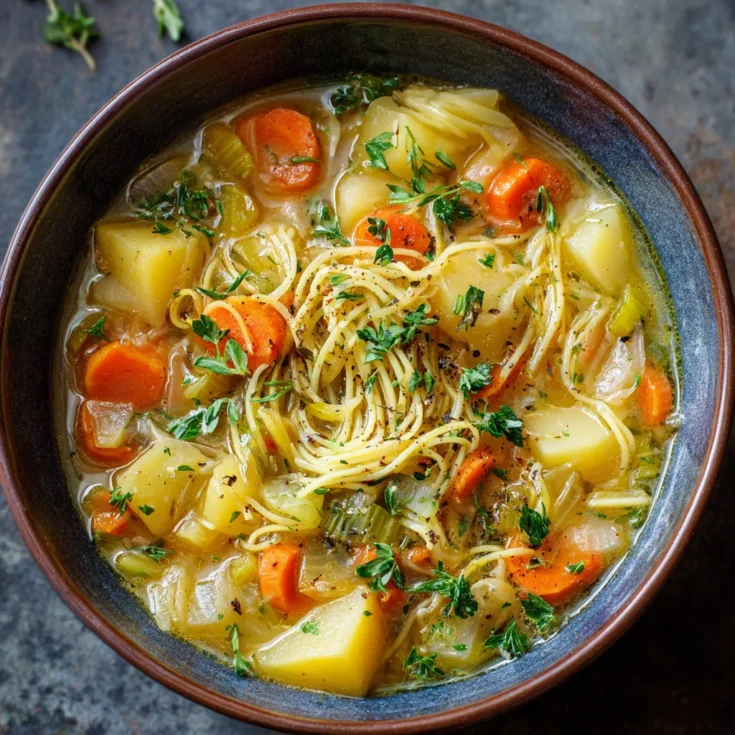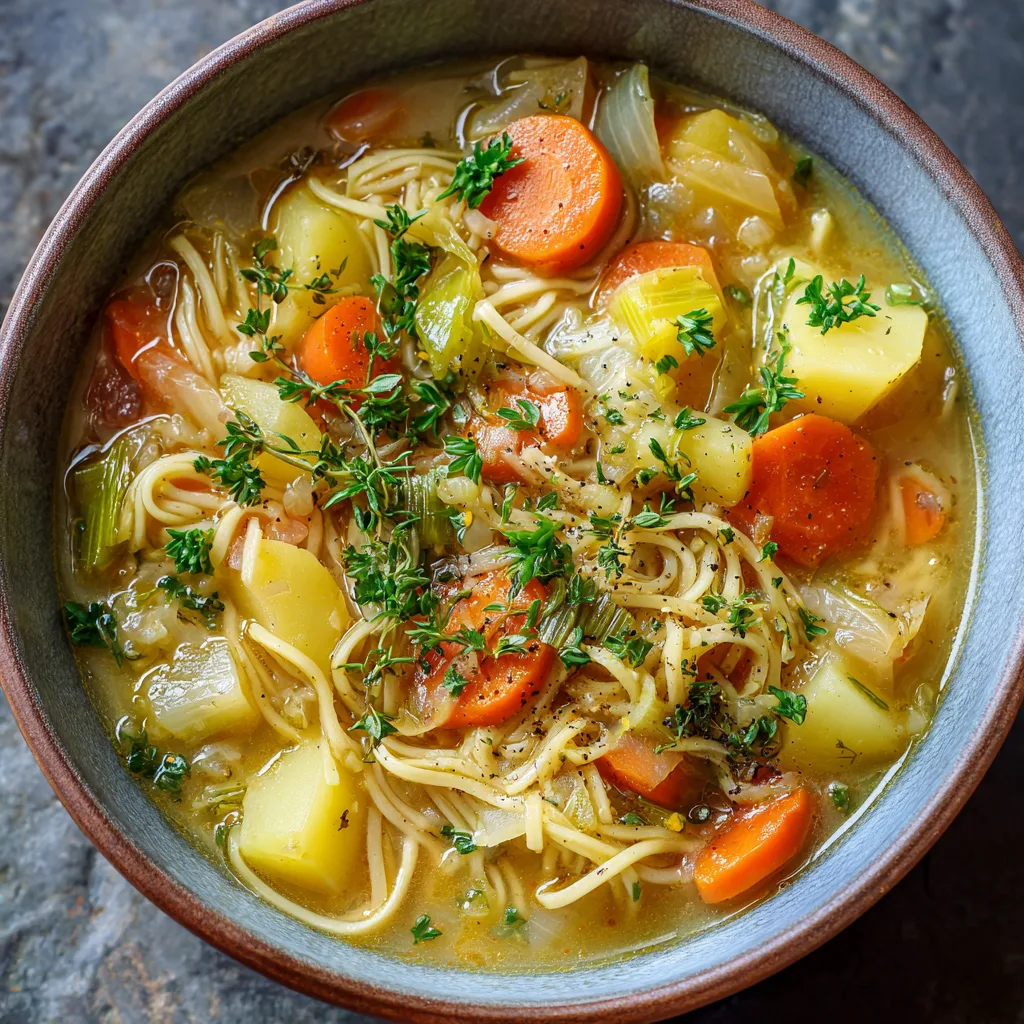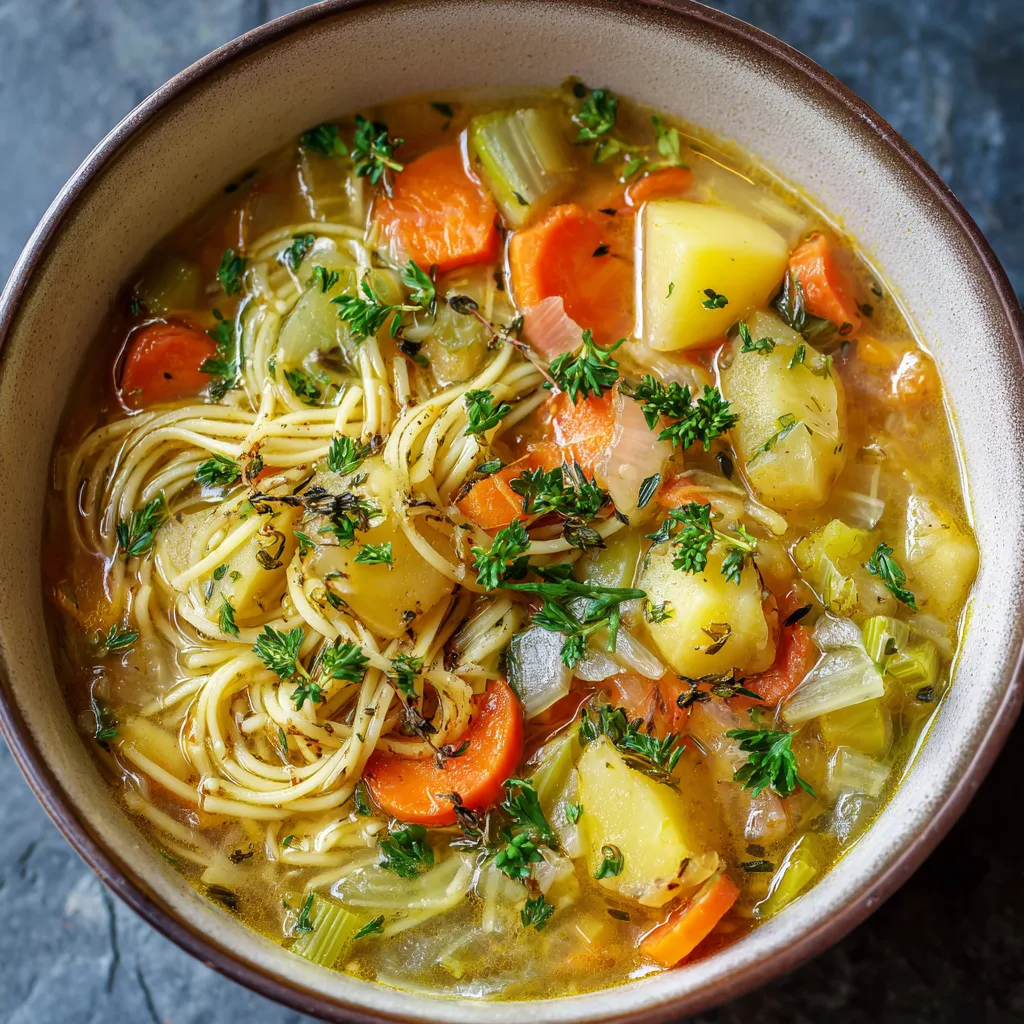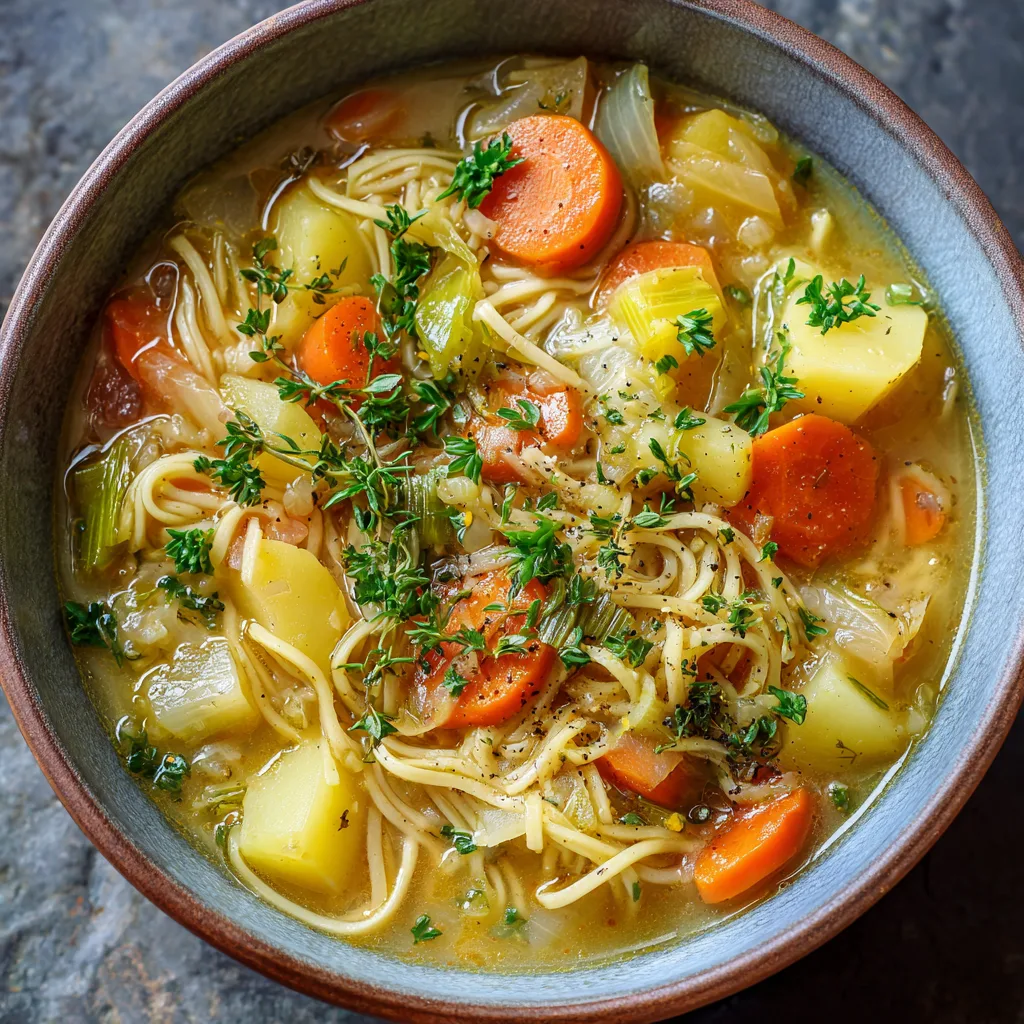Healthy Potato Noodle Soup: A Nutritious Comfort Bowl
There’s something soul-soothing about a warm bowl of soup, especially when it’s packed with flavor and health benefits. Healthy potato noodle soup is more than a cozy meal—it’s a nourishing bowl that satisfies cravings while supporting your well-being. Whether you’re fighting off a cold or simply craving something hearty yet light, this soup delivers on every front.
In this article, we’ll uncover exactly what makes potato noodle soup healthy and versatile. You’ll discover its key ingredients, nutritional advantages, and how to tweak it for different diets. From step-by-step instructions to clever add-ins, you’ll learn how to make this soup your own. Plus, you’ll get a complete recipe card for easy preparation.
Let’s explore why this dish deserves a place in your kitchen, no matter the season.
What Makes This Soup Healthy?
Unlike heavy, cream-based potato soups, this version keeps it light and clean. The foundation? Whole potatoes—rich in fiber, potassium, and vitamin C. Add in fresh vegetables, lean protein, or plant-based swaps, and you’ve got a nutrient-dense bowl that fuels you.
The broth plays a major role too. Opt for vegetable broth for a vegetarian twist or bone broth for added protein and gut-healing benefits. Skipping the cream doesn’t mean sacrificing comfort. In fact, this soup proves you can enjoy richness without the heaviness.
Compared to traditional creamy versions, this recipe keeps it wholesome and balanced. It’s a smart upgrade that brings comfort food into the realm of clean eating.
Who This Soup Is Perfect For
Healthy potato noodle soup fits a wide range of lifestyles. It’s ideal for vegetarians and those following gluten-free diets—just choose suitable noodles. It’s also a go-to for anyone seeking an immune-boosting, anti-inflammatory meal during cold seasons.
Packed with gut-friendly fiber and whole foods, it supports digestion and sustained energy. Whether you’re meal prepping or recovering from illness, this soup checks all the boxes.
Core Ingredients & Nutritional Features
Understanding what goes into healthy potato noodle soup helps highlight why it’s such a smart meal choice. Each ingredient offers specific health benefits that work together to nourish your body and support overall wellness.
Potatoes – Natural Source of Vitamin C, Potassium, and Resistant Starch
Potatoes often get a bad rap, but they’re nutrient powerhouses when prepared the right way. They’re rich in vitamin C, which supports immune function and skin health. Potassium in potatoes helps regulate blood pressure and heart function. When cooled slightly after cooking, they even form resistant starch—a type of fiber that supports gut health and keeps you full longer.
Broth Options – Bone Broth for Protein, Veggie Broth for a Plant-Based Option
The broth you choose defines both the flavor and the nutrition. Bone broth adds depth while delivering collagen, amino acids, and protein—great for joint, skin, and gut health. For a vegetarian or lighter option, vegetable broth brings minerals, antioxidants, and plant-based flavor. Both keep the soup light yet deeply satisfying.
Noodles – Whole-Grain, Potato Noodles, and Gluten-Free Choices
Noodles add comfort and texture, and the type matters. Whole-grain noodles boost fiber and complex carbs, helping stabilize blood sugar. Potato noodles offer a chewy bite and are often gluten-free, making them ideal for sensitive eaters. For even more variety, rice noodles or spiralized veggie noodles keep things fresh and customizable.
Added Vegetables & Herbs – Fiber-Rich and Anti-Inflammatory
This soup thrives on vegetables and herbs. Classic additions like leeks, carrots, and celery add fiber and antioxidants. Garlic and ginger support the immune system, while turmeric brings a golden color and powerful anti-inflammatory properties. These ingredients don’t just boost flavor—they nourish from the inside out.
Benefits of a Brothy, Veggie-Rich Soup
A brothy soup offers more than just warmth. It’s hydrating, low in fat, and loaded with nutrients. The high water content helps with satiety and digestion, while the fiber from vegetables supports gut health. A bowl of potato noodle soup makes a smart choice when managing weight, energy, or seasonal illness.
Its simplicity also makes it gentle on the stomach—ideal for recovery days or when you need a nutrient-rich reset.
Comparisons to Other Soup Varieties
Traditional creamy potato soups, though tasty, tend to be heavy. They’re often made with cream, butter, and extra starch, which increases fat and calorie content.
In contrast, this healthier version uses broth and fresh produce to keep it clean yet flavorful. Compared to immune-supporting soups like ginger-chicken broth or spicy pho, potato noodle soup holds its own as a soothing, versatile option—mild enough for all ages yet rich in nutrients that boost immunity and gut health.
Essential Ingredients
The beauty of healthy potato noodle soup lies in its flexibility. Each ingredient can be swapped, upgraded, or tailored to match your taste or dietary needs. Let’s explore the essentials that make this soup so comforting and nutritious.
Potatoes – Red, Gold, or Russet?
Red potatoes are waxy, hold their shape well, and bring a smooth texture. Gold potatoes have a buttery flavor and creamy consistency, perfect for a soft bite. Russets, with their starchy nature, break down more easily, thickening the soup slightly. Each type brings its own charm, so pick based on the texture you prefer.
Noodle Types – Choose Your Comfort
Noodles shape the comfort factor in this soup. Egg noodles offer a classic, tender bite. Potato noodles (found in many Asian dishes) are naturally gluten-free and have a chewy, springy texture. Rice noodles are light and ideal for gluten-free diets. If you’re watching carbs or want more veggies, zoodles (zucchini noodles) are a creative swap that adds color and crunch.
Broth – The Heart of the Soup
The broth sets the stage for flavor. Vegetable broth is clean, light, and plant-based. Chicken bone broth, on the other hand, delivers a deep savory taste along with collagen and minerals that support joint, skin, and gut health. Choose according to your diet—both versions offer excellent flavor foundations without excess fat or sodium.
Vegetables and Aromatics – Build the Base
Start with a classic trio: leeks, carrots, and celery. These provide sweetness, crunch, and essential vitamins. Add onion and garlic for deeper flavor and immune support. For added protein, mix in shredded chicken, white beans, or lentils. The combination creates a well-rounded, satisfying soup that’s still light and nourishing.
Optional Boosters & Flavor Enhancers
Looking to elevate your soup even more? These add-ins turn a simple bowl into something memorable.
Herbs – Depth and Brightness
Fresh herbs bring life to every bite. Use thyme for an earthy undertone, parsley for a clean finish, and dill for something slightly tangy. These herbs not only enhance taste but also offer antioxidants and digestive benefits.
Spices – Layer on the Goodness
Boost your soup’s healing power with turmeric, known for its anti-inflammatory properties. Add ginger to improve digestion and warmth. Combined with garlic, they form a flavorful trio that energizes the immune system without overpowering the broth.
Acid – A Bright Finish
A splash of lemon juice or vinegar can make all the difference. Acid brightens the soup and balances deeper flavors, especially in brothy recipes. Add it just before serving for a fresh twist.
Garnishes – Flavor and Crunch
Finish with green onion, microgreens, or sprouts for freshness. A dash of hot sauce gives a subtle kick and makes the dish your own. These little touches add texture, color, and extra flavor.
Dietary Variant Ideas
This soup is incredibly versatile. With just a few tweaks, it fits nearly every dietary lifestyle.
Vegan or Vegetarian
For a vegan or vegetarian version, swap in vegetable broth and use plant-based protein like tofu, tempeh, or beans. Erica’s potato leek noodle soup is a great model—rich in flavor without animal products.
Gluten-Free
Use certified gluten-free noodles (like rice, quinoa, or sweet potato noodles) and check broth labels for hidden wheat. This ensures a comforting, safe option for gluten-sensitive eaters.
Low-Fat or Oil-Free
For a low-fat or oil-free meal, skip the sautéing and simmer the ingredients directly in the broth. The vegetables still soften and release flavor, especially when using ginger, garlic, and turmeric. This version is especially popular in whole-food, plant-based diets.
Immune-Boosting
Need a wellness boost? Focus on ingredients like turmeric, ginger, and bone broth. Add extra garlic and finish with a squeeze of lemon for a revitalizing, flu-fighting bowl. This version is especially helpful during colder months or recovery days.
Prep & Cooking Overview
Making healthy potato noodle soup is simple when broken down into two easy phases: prep and cooking. Organizing your steps ahead of time streamlines the process and ensures every ingredient adds maximum flavor.
Prep Stage
Start with your fresh produce. Wash and chop potatoes, keeping the skin on if you’re using gold or red varieties. Skins add fiber and nutrients. For russet potatoes, peeling may help achieve a smoother texture.
Next, dice your leeks, carrots, and onion, and mince the garlic. Chop everything evenly for uniform cooking. If you’re adding greens like spinach or kale, rinse and set those aside until later.
Measure out your broth, seasonings, and herbs. Having everything ready before you start cooking helps prevent last-minute scrambling.
Boil your noodles in a separate pot. This step is key. Cooking them outside the soup prevents excess starch from thickening your broth and keeps the texture just right. Drain them a minute before they’re fully done; they’ll finish cooking in the soup.
Building the Soup
Heat a splash of olive oil or avocado oil in a large pot over medium heat. Add your onion and garlic, cooking until fragrant and softened, about three minutes. Stir in the chopped carrots and leeks, letting them cook for another five minutes.
Add the diced potatoes, followed by the broth and herbs like thyme or dill. Bring everything to a boil, then reduce to a gentle simmer. Cook uncovered for about 15–20 minutes, or until the potatoes are tender when pierced with a fork.
Now add your cooked noodles, any protein you’re using (like chicken or beans), and greens if desired. Let everything simmer for an extra two to three minutes so flavors can meld.
Just before serving, stir in a splash of lemon juice or vinegar to brighten the soup. Taste and adjust the seasonings. Garnish with parsley, green onions, or a hint of hot sauce for extra flair.
Recipe Time & Techniques
Here’s how the timing typically breaks down:
-
Prep time: 15 minutes
-
Cooking time: 20–25 minutes
-
Noodle integration and finishing touches: 5 minutes
Total time from start to finish: around 45 minutes.
Technique tips:
-
Undercook your noodles slightly so they don’t go mushy in the broth.
-
Want a thicker soup? Mash a few potato pieces before serving.
-
Prefer it brothy? Use an extra cup of broth and serve immediately after adding the noodles.
Experiment with texture preferences until you find the perfect balance for your taste.
Storage & Reheating
For best results, store the soup and noodles separately. This keeps the noodles from soaking up too much broth and becoming soft.
Refrigerate in airtight containers for up to four days. When you’re ready to eat, reheat the soup on the stovetop over medium heat or in the microwave. Add the noodles just before serving so they stay springy.
Freezing tip: Freeze only the soup base without noodles. Cool completely, pour into freezer-safe containers, and label with the date. When you’re ready to enjoy, thaw overnight in the fridge and reheat on the stove. Boil fresh noodles for a just-cooked taste.
Proper storage keeps this dish fresh, flavorful, and ready when you need a warm, nourishing meal.
Frequently Asked Questions
Answering the most common questions about healthy potato noodle soup helps make your cooking experience smoother and more satisfying. Here’s what people are asking—and what you need to know.
Can Potato Noodle Soup Be Made Vegan?
Yes, it’s easy to make this soup completely vegan. Simply use vegetable broth as your base and choose a plant-based protein like white beans, tofu, or lentils. These options add both protein and texture without any animal products. Skip the sautéing oil if you’re following an oil-free plan, and load up on vegetables like leeks, carrots, and greens. This version is just as hearty and satisfying, with clean, whole-food ingredients from start to finish.
Are Potatoes Good for Weight Loss?
Potatoes often get overlooked in weight-loss diets, but they can be beneficial when prepared simply. They are naturally low in fat, high in fiber, and packed with resistant starch, which helps with digestion and satiety. Because they’re so filling, you’re less likely to overeat. That said, portion control still matters—pair them with broth, lean protein, and vegetables for a balanced bowl.
How Do I Prevent Noodles from Getting Soggy?
To avoid soggy noodles, cook them separately from the soup. Boil until just under al dente—about one minute less than package instructions. Rinse and drain, then add them to the soup just before serving. If storing leftovers, keep the noodles and broth in separate containers to maintain the best texture.
What’s the Best Potato Type for Soup?
Choose gold or red potatoes if you prefer a smooth, creamy texture without peeling. These varieties hold their shape and cook evenly. For a heartier, thicker soup, russet potatoes are a good choice—but they tend to break down, so it’s best to peel them for consistent results.
Can I Freeze Potato Noodle Soup?
Yes, you can freeze this soup—but for best results, freeze the broth and vegetables only. Noodles often become too soft after freezing and reheating. Cook fresh noodles when you reheat the base. This keeps your soup tasting just as good as the day you made it.
Healthy Potato Noodle Soup – Cozy, Light, and Nutritious Comfort Food

A nourishing, brothy potato-noodle soup loaded with fresh vegetables, lean protein, and anti-inflammatory herbs. This comforting recipe is easy to customize and ideal for immune support.
Ingredients
- 4 cups broth (vegetable or chicken bone broth)
- 3 medium gold potatoes, diced
- 1 cup chopped carrots
- 1 cup sliced leeks (or substitute onion)
- 2 cloves garlic, minced
- 150 g noodles (egg, potato, or gluten-free)
- 1 tsp dried thyme
- Optional: 1 cup cooked shredded chicken or white beans
- Salt and black pepper to taste
- Garnish: chopped parsley, fresh lemon juice
Instructions
☐ Heat 1 Tbsp olive oil in a large pot over medium heat
☐ Sauté garlic, leeks, and carrots for about 5 minutes until softened
☐ Add diced potatoes, broth, and thyme; bring to a boil
☐ Reduce heat and simmer for 15 minutes, or until potatoes are tender
☐ In a separate pot, cook noodles according to package instructions; drain
☐ Add noodles and optional protein to the soup; simmer for 2 more minutes
☐ Season with salt, pepper, and lemon juice
☐ Serve hot, garnished with parsley
Notes
• Swap in turmeric, ginger, or dill for extra flavor and immune support
• Store soup and noodles separately to maintain texture
• Freeze the soup base (without noodles) for up to 3 months




